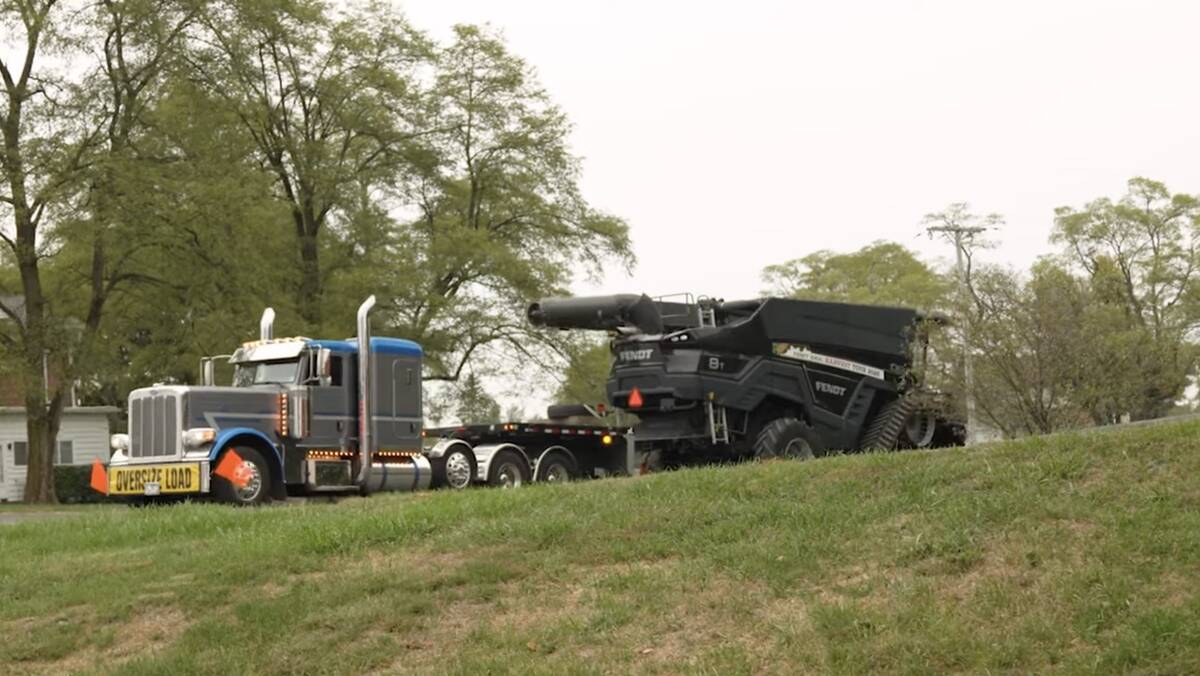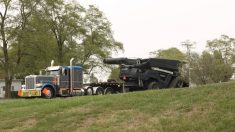BRANDON – Ray Wytinck warns that bean physiology is different from the crops farmers are used to growing.
For a good soybean crop, it’s essential to seed shallow into warm, moist soil.
“Cotyledons of a bean plant need to emerge from the soil quickly, but that burns a lot of their energy,” said Wytick of North Star Genetics in Winnipeg.
“If you plant too deep, the seed wastes more energy and it’s slow to emerge.”
Read Also

Fendt takes a combine on the road in the U.S.
Putting an Ideal combine in fields across different regions has given the brand a chance to prove that the combine is capable of performing well in a variety of conditions.
He said that gives the plant a bad start in life, and there’s nothing farmers can do to help it catch up.
“The lowest internode is where the low branches set, and that’s where your low pods will set. That’s where you get the bulk of your yield,” he said.
“If that bottom internode is close to the ground, it will be very difficult to harvest those beans. But if that lowest internode is seven to nine inches off the ground, you’ve got a good chance of getting nearly all the pods. You want that stem to stretch out as high as possible before it sets those first branches. If you put seed into cool soil, the plant gets a slow start in life. The first branches and the bulk of the pods end up close to the ground.”
Kevin Elmy of Friendly Acres Seed Farm in Saltcoats, Sask., has several years experience seeding beans outside of their usual surroundings.
“They are the last thing to seed and usually to combine.”
Wytinck said early seeding is not a priority because the soil needs to be at least 10 C.
Elmy said there is often a yield penalty for seeding early.
As well, zero till and direct seeding are out of the question because of the strict soil temperature requirement.
Wytinck said soil needs to be black for a successful soybean crop. Producers with access to strip till equipment will probably find that seeding into a six-inch wide tilled strip will work just as well as a totally black field.
Quarry Grain of Stonewall, Man., has tested many of the growing concepts that are used in Ontario and the U.S. Midwest and said other factors should be considered on the Prairies.
The company said the measure of relative maturity for beans that is used in the United States is based on the importance of daylight hours and heat.
Elmy said the corn heat units measure that is used in Western Canada to estimate soybean suitability is skewed in favour of corn, so soybeans might do better than expected in cooler areas because of the greater daylight sensitivity in some varieties of beans.
Most of the soybean varieties that are suitable for the Prairies have a corn heat unit rating below 2,550, which is the equivalent of 0.08 on the American relative maturity scale.
“The ones we like the best are 0.00s,” Elmy said.
It’s also important to avoid iron deficiency caused by high soil levels of calcium carbonate and soluable salts. Fine textured, calcareous soils with a pH above seven and those that are carrying high nitrate levels are prone to running short of available iron.
Elmy said varieties that are most resistant to iron deficiency have the best iron deficiency chlorosis scores.
IDC is measured on a scale of one to nine, with seven and eight being very resistant.
When counting days to maturity, Wytinck said farmers should begin the count from the day the cotyledon emerges rather than the day the seed goes in the ground.
Rocky fields should be rolled during seeding or immediately after seeding so farmers can run their cutterbar close to the ground. However, soybean cotyledons are rigid and breakable.
Heavy clay soil should not be rolled because the roller packs the surface, making it difficult for the young plant to emerge. It’s a major setback that can’t be overcome during the growing season.
Wytinck said it’s important to use the correct inoculants and have them applied by a seed dealer who has good seed treatment equipment. He discouraged growers from applying the seed treatment themselves.
Elmy said inoculation is critical because the soil has no experience with the soybean rhizobia.
“There is no indigenous populations. The bugs that support the inoculants don’t exist, either,” he said.
Agronomist Garry Hnatowich of Novozymes said two applications of inoculant should be used: one stuck to the seed, liquid or peat and the other a granular that is seed row placed.
“And consider using the same manufacturer for both. That helps ensure you are placing the same strain (of rhizobium) in the soil in both cases,” Hnatowich said.
“We aren’t just sure if two different strains will compete and hurt results, but we are sure that if they are the same one they won’t.”
Seed should be planted as soon as possible after inoculation.
Agronomists and producers who have planted the crop in the Dakotas and Saskatchewan say fields with low residual nitrogen do the best because they don’t artificially extend the plants’ vegetative state, preventing flowering and podset.
Glyphosate should be applied in warm weather. In cool weather, the herbicide can turn the plants slightly yellow and set them back, which delays maturity. To avoid damage, Wytinck advised farmers to spray when the temperature is higher than 10 C.
Wytinck said it’s not as difficult as it seems to grow soybeans, as long as the grower remembers that they are touchy plants and the rules need to be followed.
“Beans are not resilient,” he said.
“Every single compromise will lower your yield at the end of the season. They survive, but they don’t have the ability to really bounce back to their full potential.”
However, they also tolerate a fair bit of frost at the end of the season without major consequences.
“If you have a variety that needs 115 days to mature, and you’re in an area with 105 or 110 frost free days, it’s still possible to harvest a decent crop. That’s because those frosts near harvest time don’t hurt the pods.”
Wytinck said only serious bean growers buy specialized bean combines. They do a better job of catching more beans and treating them gently, but it’s not a necessary piece of equipment for a first time grower.
“A straight cut flex header that can cut close to the ground is really all you need. Some guys have swathed, but that leaves a lot of beans on the ground.”















